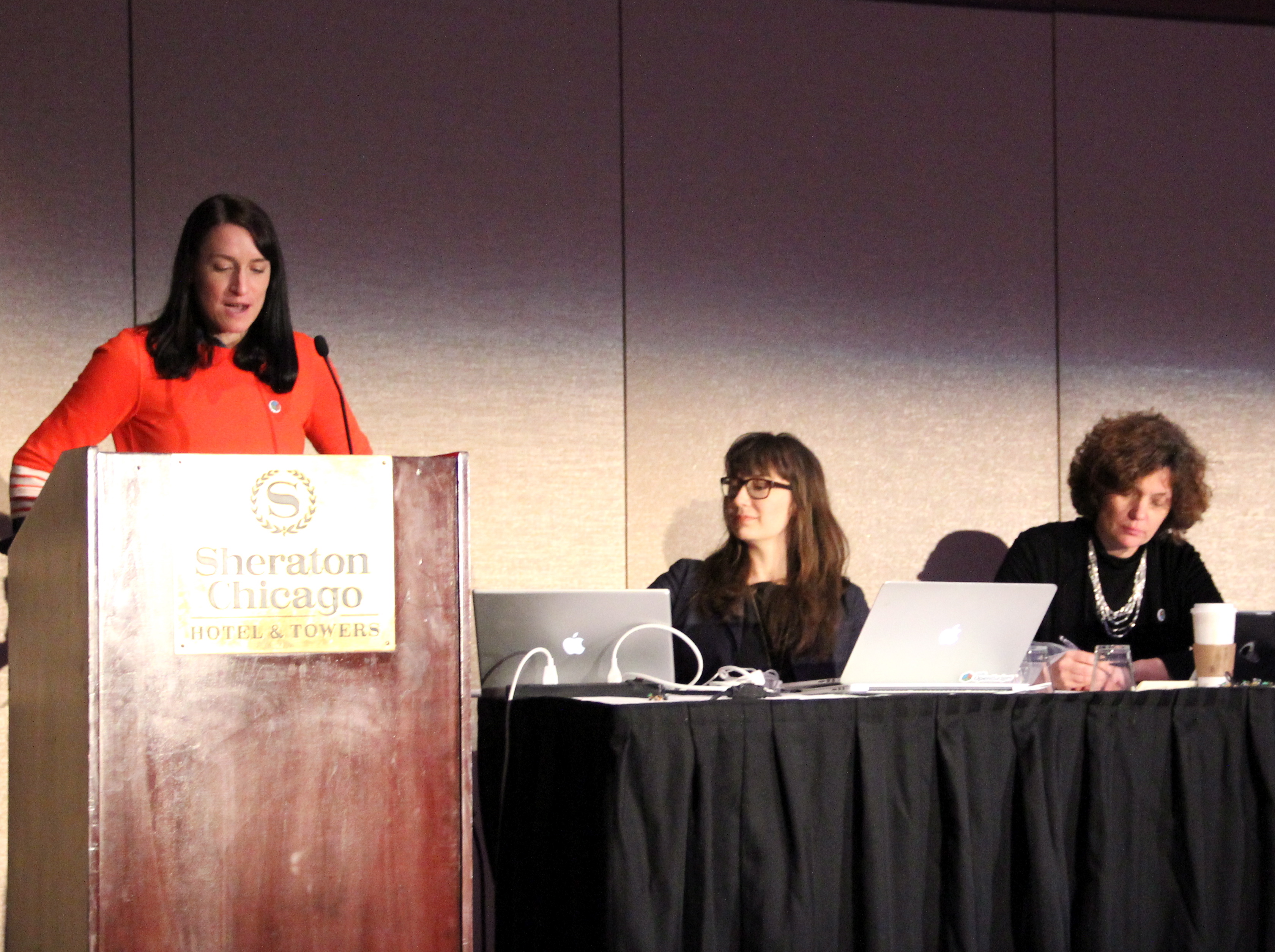Newsroom
Linking Recognition, Certification & Accreditation to Anytime, Anywhere Learning
A Few Moments with Erin Knight

As Senior Director of Learning and Badges at Mozilla Foundation, Erin Knight is leading the development of the organization’s Open Badges Infrastructure in an effort to provide adults and youth ages 13-17 with an alternative accreditation and credentialing system for learning. Knight and her team announced the launch of Open Badges 1.0, a new online standard to recognize and verify learning, at last month’s 2013 Digital Media and Learning Conference in Chicago. Knight has also recently published a working paper in which she proposes an open, distributed system for badge validation. We spent a few moments with Knight to learn more about the platform’s potential to certify informal learning and what role badging can play in shaping the future of education.
Open Badges 1.0 has been described as a “critical piece of the connected learning ecosystem.” How does badging fit into this model if the ecosystem itself is still evolving?
Open Badges enable you to connect different types of learning to each other. The whole point of connected learning by definition — by the name itself –- is to find a way to connect things. To do that, we need something that will carry that information across sectors. In the connected learning vision, I see badges as the connectors between different spheres. Badges play the role of a currency where learning can be captured, recognized, and then communicated across those lines.
There’s an even bigger opportunity here when thinking about a badge system at an umbrella level, so that, for example, all of the organizations in a city that are embracing connected learning have a standard to level-up to or align with. One of the new additions to the badge standards is a push for this standards alignment. This could be anything from traditional standards to competency frameworks to even web literacy standards. You can imagine building a learning standard that explicitly outlines the values of connected learning so all of the organizations that are participating have something to align to.
How can you be sure badging won’t just impose another adult top-down criteria of success for young people?
That’s one of the best things about Open Badges — it allows the learners to be in control.
I have heard this question a lot — don’t muck up interest-based learning. There are some pretty big assumptions there. The first is that kids really are discovering these learning experiences. I don’t know if it’s completely true that kids truly feel they have access to this stuff. The other assumption is that kids who are doing this type of learning realize it is real. We have seen so many stories of kids who are not doing well in school so they go to an afterschool program and become videographers and produce inspiring documentaries, yet they still feel like they are bad students. As a result, they end up dropping out or have self-esteem issues because they can’t connect the two. They don’t understand that their learning outside of school was actually legitimate and could have led to a job opportunity or could have demonstrated that they were capable of doing something. It’s a really big assumption to say that that’s not a problem.
When it comes to badges, learners are in control. If they are offered a badge they don’t want, they don’t have to accept it. They can choose to decide what is valuable and what is not valuable to them. In addition, not all badges need to be adult issued. There’s a lot of value in thinking about those social skills and peers skills. We are already seeing some badge systems where some of the adult scaffolding is present, but there is also an opportunity for youth to actually issue badges around what they care about to their friends. Some may say those badges aren’t valuable because they are not authority driven, but combined with some of the other robust assessment badges, they start to tell you a really cool story about youth.
What next steps need to be taken to ensure those who don’t have access to technology, and who are most in need of an alternative credential system, are not shut out from these opportunities?
The thing to keep in mind as we approach these challenges is that ultimately, Open Badges are about expanding access and opportunity. So it’s very important to us to make sure as many people as possible are able to participate.
If you look at platforms such as Coursera, you’ll notice a huge percentage of participants are from third world countries and rural areas. They have access to this type of learning, but they don’t have a way to connect it to jobs or to real opportunities. The first step is to build a recognition system on top of these open access platforms that are already touching these remote areas so we can open up more opportunities for people. This will help legitimize this learning and help make it more transferable. Next, we have to think about how to reach and support people who don’t have computers.
In Chicago, we have a variety of offline badges available so kids who don’t have access to computers, but who participate in city programs, can get offline badges and claim them digitally using the library. We know mobile is a big step in this equation. We are in talks to develop a set of mobile apps to support this. One would be a mobile app to accept and collect badges and another would be a way for organizations to issue badges through a smartphone. You can imagine everyone from the parks department having a smartphone, which they can easily issue badges from to the kids instead of having to hand them a card badge.
We are even going as far as exploring SMS badging. Seeing badges through your mobile device is one piece of it, and on a smartphone it’s relatively easy to do, but we want to take it further. Maybe there is a way to allow people to badge via SMS, accept via SMS, and transfer their badges via SMS. We want to leverage that. It’s definitely on our radar, and we would need to partner with somebody in order to get it done. This redefines and opens up learning completely, which is no small feat.
Creating an online identity is a critical part of youth development. Are there any workarounds to current privacy restrictions so that youth under 13 could have access to the Mozilla backpack?
We want to protect children but also support lifelong learning, so for us, it presents an interesting question. We talk about lifelong learning all of the time in the digital media and learning community and at Mozilla. Lifelong learning should not have to start at age 13, but its not as easy as that — there are also responsibilities and regulations that come into play once you start working with data that belongs to kids under 13.
Providers can still issue badges to youth under the age of 13, but they can’t push those badges beyond their own organization. As a kid, for example, I can go to Club Penguin or DIY.org and have meaningful experiences and earn badges; I just can’t take them with me outside of that community. And that’s OK. It’s not holding back these kids from having meaningful learning experiences, but it’s not helping them connect and take their experiences further. In thinking about this from the backpack perspective, it’s really about creating an identity for kids online that can extend across a lot of different sites. No one has done it yet because there are a lot of liabilities, but we recognize how important it is.
One of the things we are building for the city of Chicago is a separate backpack for kids who are under 13. It is tied to a parent’s email, and it has no sharing features. I can’t publish badges through public URLs, and I can’t post them on Facebook. I can only collect them. The benefit is I can collect them and get badges across multiple learning issuers, and I keep them for an extended period of time. They can also translate back to school. We are using Chicago as a lab so we can see how this works with the intention of doing it in a larger capacity for the broader ecosystem. The goal is for issuers to push badges for kids under 13 to a very specific set of backpacks, which would then allow youth to graduate to the open sharable backpacks. It doesn’t currently work this way because every issued badge is tied to an email address. In order for us to do this in a big way, we have to solve this piece so that there’s some way for youth to roll all of those badges earned prior to age 13 into their new Mozilla backpacks.
Of the more than 600 organizations using Open Badges, are there any that are currently tying badge issuing to in-school environments?
The Providence Afterschool Alliance (PASA) does a lot with out-of-school curricula and incorporates digital badges into those courses. The organization just recently announced that some of the high schools and community colleges in its area were accepting those badges as credit, which is a really big deal. To me, that’s a huge success because it legitimizes the learning that is taking place in the afterschool context, but also, the fact that these schools are accepting it makes a big statement about both the types of learning that can take place outside of school and also how badges can translate and recognize that.
Purdue University has launched a university-wide system recognizing extra curricular activities that wouldn’t necessarily show up on a student’s transcript such as school clubs, volunteering etc. They also have a tool that allows professors to create badges within their own departments as a way to balance grades with a more granular recognition of learning. The ultimate goal is that if two people receive the same degree, but have a very different learning path underneath the degree, that information is exposed and shared.
Were alternative settings and learning pathways a part of your life growing up?
Growing up, I was always the A student. I just wanted to do well, and I measured that by whatever measurement I was told mattered. I didn’t consciously think about it, but I certainly didn’t want to try different paths because I wanted to do what I had to do in order to get recognized.
I have an 18-month-old baby, and I see the wonder of learning in his eyes. I want him to keep that forever. I want that back myself! I want us to really have an opportunity to create interest-driven and customized learning pathways and to be able to explore the things we care about and have them count for us across our lifetime.
While studying the benefits of technology, specifically social media, in the classroom, I started grappling with this concept of assessment. How do you start to recognize social behaviors when grades are your only assessment tool? I wanted something more flexible and more innovative that would open up learning in a very real way. That’s why I was attracted to badges. They’re cheap, and they’re sizable. It’s the first thing I have ever seen that is flexible enough to have a chance to open up learning. I believe in it, but it’s way bigger than me. We have this opportunity in front of us to make a big impact, and I can’t wait to see where it can go.

